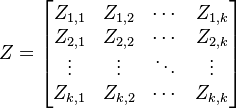Multiregional Input-Output Model
Contents
Definition
Multiregional Input-Output Model (MRIO) is an extension of the basic (implicitly single region) Input-Output Model that encompasses economies that operate under different jurisdictions.[1]
Structure
Input-output models covered originally only a single region of production and trade but have been extended to represent multiple regions, better capturing the globalized nature of modern commodity trade.
In general, IO tables describe an economy’s production structure (or several economies/regions in the case of a multi-regional IO table). The IO table represents the economic activities (output) of the economy. The production sectors (primary, secondary and tertiary sectors) and categories of final demand (consumption, investment) are listed in columns.
The corresponding intermediate inputs of these activities and sectors as well as their primary inputs (value-added; composed of wages, salaries and operating surplus) are reported in the rows of the IO table. Consequently, the columns represent the cost structure of a sector (“input”) and the corresponding rows represent the composition of that sector’s revenues (“output”). For each sector, the sum of inputs equals the sum of outputs.
MRIO tables usually (but not necessarily) require that all countries included have a uniform sectoral structure. Furthermore, export and import data must be available or calculated within the same sectoral structure.
Numerous assumptions have to be made in this regard (e.g., allocating trade data to intermediate usage and final demand). Exports reported by a source country to a destination country often do not exactly match the imports reported by that destination country. Reasons for such differences may include different valuation methods, time delays between exports and imports, and different sector classifications of products. Furthermore, exchange rates must be applied, as national IO tables are provided in national currencies and must be converted to a uniform currency for the MRIO table.
The compilation of data to build an MRIO table must also address the fact that row and column totals are usually not equal. Therefore, different balancing techniques can be applied. In order for an MRIO table to map the entire world, countries that are not explicitly covered are usually included in one or more residual regions (e.g., Rest Of World Account, or “RoW”). While the sum of transactions for that region can be calculated, there is no detailed mapping of the economic structure.
Formula
Entries  describing the intermediate i,j purchases (input flows) by industry i in country p from sector j in country q. These can be represented in Partitioned Matrix form as follows:
describing the intermediate i,j purchases (input flows) by industry i in country p from sector j in country q. These can be represented in Partitioned Matrix form as follows:
Each submatrix on the main diagonal  represents the domestic interactions for each industry n. The off-diagonal matrices
represents the domestic interactions for each industry n. The off-diagonal matrices  describe the trade from region i to region j for each industry.
describe the trade from region i to region j for each industry.
The market balance in the global economy The global economy can be represented as:
with e representing the summation vector (column vector with 1's of appropriate dimension) and x the total industry output.
Usage
Multi-regional input-output analysis is increasingly used to analyze the environmental implications of consumption, be it for greenhouse gas emissions, land use, and water use. Input-output tables display the interconnection between different sectors of production and allow for a tracing of the production and consumption in an economy.[2]
Particularly for environmental impacts with global implications, such as global warming, it is important to calculate the global environmental impacts for production and consumption. Imports are generally produced in countries with different production technologies and energy mixes compared to the domestic economy. This suggests that a multi-regional model is required to correctly evaluate the pollution embodied in traded products.
Issues and Challenges
- In practice, the underlying national IO tables are usually not uniform and, hence, need to be harmonized when creating an MRIO table. Different approaches to harmonization can be used, which leads to different results. Furthermore, for a detailed multi-regional MRIO table, it is, in theory, necessary for all monetary transactions between all economic sectors worldwide to be measured consistently and uniformly. As this is not given, MRIO tables are constructed based on national IO tables, national account data, production statistics, household surveys, international trade data and other data sets.
- Makers of MRIOs must combine multiple datasets which present conflicting information on the nature of the economy and the environment. For example, exports from country A to country B might be different from imports by country B from country A. An important source of data for MRIOs is international trade statistics from the UN, but these do not perfectly conform to the national accounts of a given country. Further, the financial information for industries responsible for substantial carbon emissions may not conform well with other sources of information regarding their emissions.
- With regard to multi-regional input-output databases, some provide both the IO table and the coefficients matrix, while other provide only the IO table or the input coefficients matrix. However, the input coefficients matrix is required for impact measurement. Together with the inverse matrix, which is either provided by IO databases or must be derived from the coefficients matrix, it serves as a starting point for impact calculations.
- In an MRIO model, exchange rates are needed to link the data from different regions to a common currency.
- The data covering a variety of regions is likely to come from various time periods.
- The IO data from different regions is often in different classification systems.
- Data is collected based on entirely different conceptual framework. For example, IO data in an industry classification is based on industries being the smallest unit, while consumer expenditure survey data is collected on the basis of products and functions being the smallest unit

